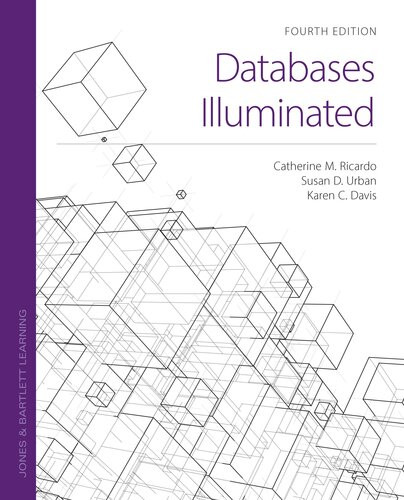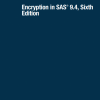Databases Illuminated 4th Edition by Catherine M Ricardo, Susan D Urban, Karen C Davis ISBN 1284231585 9781284231588
$50.00 Original price was: $50.00.$25.00Current price is: $25.00.
Databases Illuminated 4th Edition by Catherine M Ricardo, Susan D Urban, Karen C Davis – Ebook PDF Instant Download/Delivery: 1284231585 ,9781284231588
Full download Databases Illuminated 4th Edition after payment

Product details:
ISBN 10: 1284231585
ISBN 13: 9781284231588
Author: Catherine M Ricardo, Susan D Urban, Karen C Davis
Databases Illuminated 4th Edition Table of contents:
1 Introductory Database Concepts
1.1 Uses of Databases
1.2 A Sample Database
1.3 The Integrated Database Environment
1.4 Roles in the Integrated Database Environment
1.5 Advantages of the Integrated Database Approach
1.6 Historical Developments in Information Systems
1.6.1 Developments in Storage Media
1.6.2 Database Models
1.7 Big Data
1.8 Chapter Summary
Exercises
2 Database Planning and Database Architecture
2.1 Data as a Resource
2.2 Characteristics of Data
2.2.1 Data and Information
2.2.2 Levels of Discussing Data
2.2.3 Data Sublanguages
2.3 Stages in Database Design
2.4 Design Tools
2.4.1 Data Dictionary
2.4.2 Diagramming Tools
2.4.3 CASE Packages
2.5 Functions of the Database Administrator
2.5.1 Planning and Design
2.5.2 Developing the Database
2.5.3 Database Management
2.6 The Three-Level Database Architecture
2.6.1 External Views
2.6.2 Logical Model
2.6.3 Internal Model
2.6.4 Physical Level
2.6.5 Record Retrieval
2.6.6 Data Independence
2.7 Overview of Data Models
2.7.1 The Entity-Relationship Model
2.7.2 Relational and Other Record-Based Models
2.7.3 Object-Oriented Model
2.7.4 Object-Relational Model
2.7.5 Data Warehouse Models
2.7.6 Semistructured Data Models
2.7.7 Big Data and NoSQL Models
2.8 Chapter Summary
Exercises
3 The Entity-Relationship Model
3.1 Purpose of the Entity-Relationship (ER) Model
3.2 Entities
3.3 Attributes
3.3.1 Domains
3.3.2 Null Values
3.3.3 Multivalued Attributes
3.3.4 Composite Attributes
3.3.5 Derived Attributes
3.4 Keys
3.4.1 Superkeys
3.4.2 Candidate Keys
3.4.3 Primary Keys
3.5 Relationships
3.5.1 Degree of Relationships
3.5.2 Attributes of Relationship Sets
3.5.3 Cardinality of a Relationship
3.5.4 Showing Cardinalities in an ER Diagram
3.5.5 Participation Constraints
3.5.6 Using (min,max) Notation for Cardinality and Participation
3.6 Roles
3.7 Existence Dependency and Weak Entities
3.8 Sample ER Diagrams
3.9 The Extended Entity-Relationship Model
3.10 Generalization and Specialization
3.10.1 Specialization
3.10.2 Generalization
3.10.3 Generalization Constraints
3.10.4 Multiple Hierarchies and Inheritance
3.11 Union
3.12 Sample EER Diagrams
3.13 Chapter Summary
Exercises
4 The Relational Model
4.1 Advantages of the Relational Model
4.2 Relational Data Structures
4.2.1 Tables
4.2.2 Mathematical Relations
4.2.3 Database Relations and Tables
4.2.4 Properties of Relations
4.2.5 Degree and Cardinality
4.2.6 Relation Keys
4.3 Integrity Constraints
4.4 Representing Relational Database Schemas
4.5 Relational Data Manipulation Languages
4.5.1 Categories of DMLs
4.5.2 Relational Algebra
4.6 Views
4.7 Mapping an ER Model to a Relational Schema
4.8 Mapping an EER Model to a Relational Schema
4.8.1 Summary of ER to Relational Mapping Concepts
4.8.2 Mapping EER Set Hierarchies to Relational Tables
4.8.3 Mapping Unions
4.8.4 EER to Relational Mapping Example
4.9 Forward and Reverse Engineering: ER and Relational Models
4.10 Chapter Summary
Exercises
5 Relational Database Management Systems and SQL
5.1 Brief History of SQL in Relational Database Systems
5.2 Architecture of a Relational Database Management System
5.3 Defining the Database: SQL Data Definition Language (DDL)
5.3.1 Create Database, Create Schema
5.3.2 Create Table
5.3.3 Create Index
5.3.4 Alter Table, Rename Table
5.3.5 Drop Statements
5.3.6 Additional SQL DDL Example
5.4 Manipulating the Database: SQL Data Manipulation Language (DML)
5.4.1 Introduction to the Select Statement
5.4.2 Select Using Multiple Tables
5.4.3 Select with Aggregate Functions
5.4.4 Select With Group By
5.4.5 Select with Pattern Strings
5.4.6 Operators For Updating: Update, Insert, Delete
5.5 Creating and Using Views
5.6 The System Catalog
5.7 Chapter Summary
Exercises
6 Normalization and Denormalization
6.1 Objectives of Normalization
6.2 Insertion, Update, and Deletion Anomalies
6.3 Functional Dependency
6.4 Superkeys, Candidate Keys, and Primary Keys
6.5 Normalization Using Candidate Keys
6.5.1 First Normal Form
6.5.2 Full Functional Dependency and Second Normal Form
6.5.3 Transitive Dependency and Third Normal Form
6.5.4 Boyce-Codd Normal Form
6.5.5 Comprehensive Example of Functional Dependencies
6.6 Properties of Relational Decompositions
6.6.1 Attribute Preservation
6.6.2 Dependency Preservation
6.6.3 Lossless Decomposition
6.6.4 Decomposition Algorithm for Boyce-Codd Normal Form with Lossless Join
6.7 Higher Normal Forms
6.8 The Normalization Process
6.8.1 Analysis
6.8.2 Synthesis
6.8.3 Normalization from an Entity-Relationship Diagram
6.9 When to Stop Normalizing
6.10 Non-normalized Databases
6.11 Chapter Summary
Exercises
7 Advanced SQL
7.1 Introduction to Advanced SQL Features
7.2 Additional SQL Functions
7.2.1 Numeric Single-Row Functions
7.2.2 Character Single-Row Functions
7.2.3 Date and Time Functions
7.3 Sequences
7.4 Temporal Databases and SQL
7.4.1 User Valid Time
7.4.2 Transaction Time
7.5 SQL Programming
7.5.1 SQL Persistent Stored Modules (PSMs)
7.5.2 Embedded SQL
7.5.3 Application Programming Interfaces (APIs)
7.5.4 Dynamic SQL
7.6 Using COMMIT and ROLLBACK Statements
7.7 Active Databases
7.7.1 Enabling and Disabling Constraints
7.7.2 SQL Triggers
7.8 Global and Private Temporary Tables
7.9 Java Database Connectivity (JDBC)
7.9.1 Developing a JDBC Application
7.9.2 The Statement Object
7.9.3 The PreparedStatement Object
7.9.4 The CallableStatement Object
7.9.5 Updating the Database
7.9.6 Querying Metadata
7.10 Chapter Summary
Exercises
8 Introduction to Database Security
8.1 Issues in Database Security
8.1.1 Accidental Security Threats
8.1.2 Deliberate Security Threats
8.2 Fundamentals of Access Control
8.2.1 Physical Security
8.2.2 Information System Access Control
8.3 Database Access Control
8.4 Using Views for Access Control
8.5 Security Logs and Audit Trails
8.6 Encryption
8.6.1 Symmetric Key Encryption
8.6.2 Public-Key Encryption
8.7 Data De-identification
8.8 SQL Data Control Language (DCL)
8.9 Security in Oracle
8.9.1 Security Features
8.9.2 Oracle Security Tools
8.9.3 Administrative Accounts
8.9.4 User Privileges
8.9.5 Creating and Managing User Accounts
8.10 Statistical Database Security
8.11 SQL Injection
8.11.1 SQL Vulnerability
8.11.2 Further Examples of SQL Injection
8.11.3 Mitigation of SQL Injection
8.12 Database Security and the Internet
8.12.1 Proxy Servers
8.12.2 Firewalls
8.12.3 Digital Signatures
8.12.4 Certification Authorities
8.13 Chapter Summary
Exercises
9 Object-Based Models
9.1 Rationale for the Object-Oriented Data Model
9.2 Object-Oriented Data Concepts
9.2.1 Objects and Literals
9.2.2 Classes
9.2.3 Class Hierarchies and Inheritance
9.2.4 Object Identity
9.3 Object-Oriented Data Modeling Using UML
9.4 The ODMG Model and Object Definition Language (ODL)
9.4.1 Class Declarations
9.4.2 Extent
9.4.3 Attributes
9.4.4 Relationships
9.4.5 Methods
9.4.6 Classes and Inheritance
9.4.7 N-ary Relationships and M:N Relationships with Attributes
9.4.8 Keys
9.5 Object Query Language (OQL)
9.6 Developing an OO Database Application
9.6.1 Overview of InterSystems Iris
9.6.2 Schema Definition in Iris
9.7 Extending the Relational Model
9.7.1 Large Object Data Types
9.7.2 Structured Types
9.7.3 UDTs
9.7.4 Reference Types
9.7.5 Type Hierarchies in Standard SQL
9.7.6 Type Hierarchies in Oracle
9.7.7 Nested Tables in Oracle
9.7.8 Oracle Object Views
9.8 Converting a UML Diagram to an Object-Relational Database Model
9.9 Converting an EER Diagram to an Object-Relational Database Model
9.10 Chapter Summary
Exercises
10 Relational Query Optimization
10.1 Query Processing and Query Optimization
10.2 Logical Query Optimization
10.2.1 The Query Tree
10.2.2 An SQL Query and Its Relational Algebra Translation
10.2.3 Performing SELECT Operations Early
10.2.4 Evaluating Conjunctive Conditions
10.2.5 Performing PROJECT Early
10.2.6 Equivalence of Algebraic Operations
10.2.7 Heuristics for Query Optimization
10.3 Physical Query Optimization
10.3.1 Cost Factors
10.3.2 Cost of Processing Selects
10.3.3 Processing Joins
10.3.4 Processing Other Operations Projection
10.3.5 Adaptive Query Optimization
10.3.6 Pipelining
10.4 Query Optimization in Oracle
10.5 Chapter Summary
Exercises
11 Transaction Management
11.1 ACID Properties of Transactions
11.2 Need for Concurrency Control
11.2.1 The Lost Update Problem
11.2.2 The Uncommitted Update Problem
11.2.3 The Problem of Inconsistent Analysis
11.3 Serializability
11.4 Locking
11.4.1 Deadlock and Starvation
11.4.2 Two-Phase Locking Protocol
11.4.3 Levels of Locking
11.5 Timestamping
11.5.1 Basic Timestamping Protocol
11.5.2 Thomas’s Write Rule
11.5.3 Multiversion Timestamping
11.6 Optimistic Techniques
11.7 Need for Recovery
11.8 Recovery Techniques
11.8.1 Deferred Update Protocol
11.8.2 Checkpoints
11.8.3 Immediate Update Protocol
11.8.4 Shadow Paging
11.8.5 Overview of the ARIES Recovery Algorithm
11.9 Transaction Management in Oracle
11.9.1 Transaction Limits
11.9.2 Isolation Levels
11.9.3 Types of Locks
11.9.4 Recovery Management
11.10 Chapter Summary
Exercises
12 Distributed Databases
12.1 Rationale for Distribution
12.2 Architectures for a Distributed System
12.2.1 Distributed Processing Using a Centralized Database
12.2.2 Client-Server Systems
12.2.3 Parallel Databases
12.2.4 Distributed Databases
12.2.5 Peer-to-Peer Data Management Systems
12.2.6 Cloud Database Systems
12.3 Components of a Distributed Database System
12.4 Data Placement
12.5 Transparency
12.6 Transaction Control for Distributed Databases
12.6.1 Concurrency Control
12.6.2 Recovery
12.7 Distributed Query Processing
12.7.1 Steps in Distributed Query Processing
12.7.2 The Semijoin Operation
12.8 Blockchain Technology
12.8.1 Blockchain Architecture and Functionality
12.8.2 Blockchain Benefits and Future Directions
12.9 Chapter Summary
Exercises
13 Semistructured Data
13.1 Data and the Internet
13.2 A Semistructured Data Model
13.3 JavaScript Object Notation (JSON)
13.4 Extensible Markup Language (XML)
13.4.1 Standalone XML Documents
13.4.2 Document Type Definition (DTD)
13.4.3 XML Schema Definition (XSD)
13.4.4 XML Data Manipulation
13.4.5 XML Parsers
13.5 JSON and XML in Relational Databases
13.6 Oracle Implementation of Semistructured Data
13.6.1 JSON in Oracle
13.6.2 XML DB
13.6.3 Oracle XML Developer Kits
13.7 Chapter Summary
Exercises
14 Big Data and NoSQL
14.1 Big Data
14.2 Distributed File Systems and Parallel Programming Paradigms
14.2.1 Hadoop Distributed File System
14.2.2 MapReduce
14.2.3 Spark
14.2.4 Hive and HiveQL
14.3 NoSQL
14.3.1 Defining NoSQL Technology
14.3.2 NoSQL Systems
14.4 A Document Database System: MongoDB
14.5 A Graph Database System: Neo4j
14.6 Chapter Summary
Exercises
15 Data Warehouses
15.1 Origins of Data Warehousing
15.2 Operational Databases and Data Warehouses
15.3 Components of a Data Warehouse
15.4 Data Warehouse 3-Level Architecture
15.5 Data Lakes
15.6 Developing a Data Warehouse
15.6.1 Top-Down Method
15.6.2 Bottom-Up Method
15.6.3 Data Vault Method
15.7 Data Models for Data Warehouses
15.7.1 Star Schema and Snowflake Schema
15.7.2 Data Cubes and Hypercubes
15.7.3 Semistructured Data
15.7.4 Column Stores
15.8 Data Warehouse Administration
15.9 Views and View Materialization
15.10 Data Analytics
15.10.1 Techniques for ROLAP
15.10.2 Basic Data Cube Operations
15.10.3 SQL Analytic Functions
15.11 Data Mining
15.11.1 Purpose of Data Mining
15.11.2 Types of Knowledge Discovered
15.11.3 Models and Methods Used
15.11.4 Applications of Data Mining
15.12 Chapter Summary
Exercises
16 Social, Ethical, and Legal Issues
16.1 Computerization and Society
16.2 Ethical Issues in Information Technology
16.2.1 A Framework for Ethical Decision Making
16.2.2 Ethical Standards for Computing Professionals
16.3 Databases and Privacy Issues
16.3.1 Privacy and Security
16.3.2 Privacy as a Human Right
16.3.3 Privacy Legislation in the United States
16.3.4 Privacy Legislation in the European Union
16.3.5 Privacy Legislation in Other Countries
16.4 Intellectual Property
16.4.1 Definition of Intellectual Property
16.4.2 Legal Protections for Intellectual Property
16.4.3 Intellectual Property Protection for Software
16.5 Chapter Summary
Exercises
Index
People also search for Databases Illuminated 4th Edition:
databases used in everyday life
databases illuminated 3rd edition
databases illuminated fourth edition
databases illuminated 3rd edition solutions pdf
databases illuminated 4th edition
Tags: Catherine M Ricardo, Susan D Urban, Karen C Davis, Databases Illuminated
You may also like…
Travel - Europe - Travel
Pocket Vienna 4th Edition by Catherine Le Nevez 1788688716 9781788688710
Chemistry - Biochemistry
Chemistry - Analytical Chemistry
Biology and other natural sciences
Business & Money
Relationships & Lifestyle - Women's Health & Lifestyle











